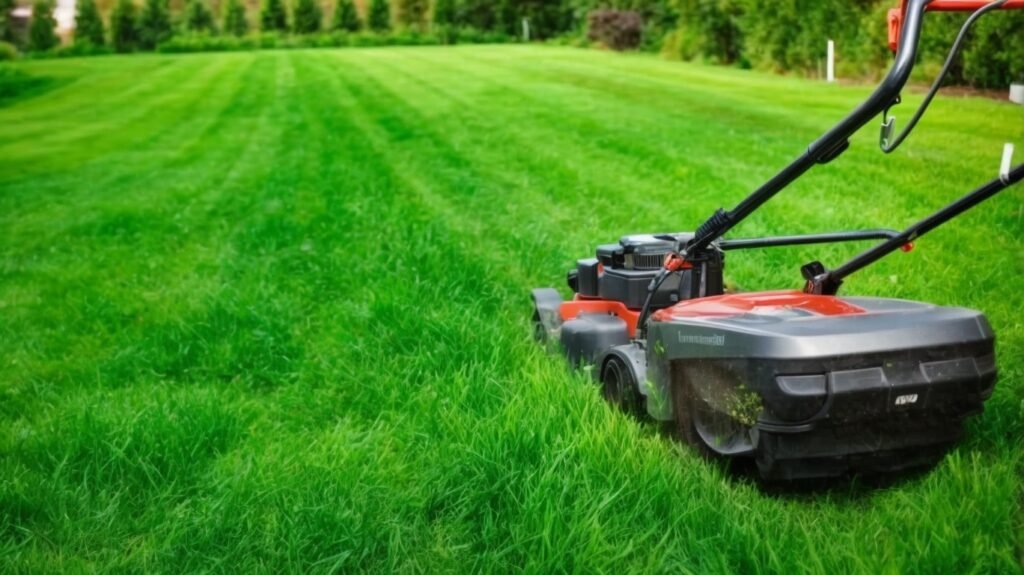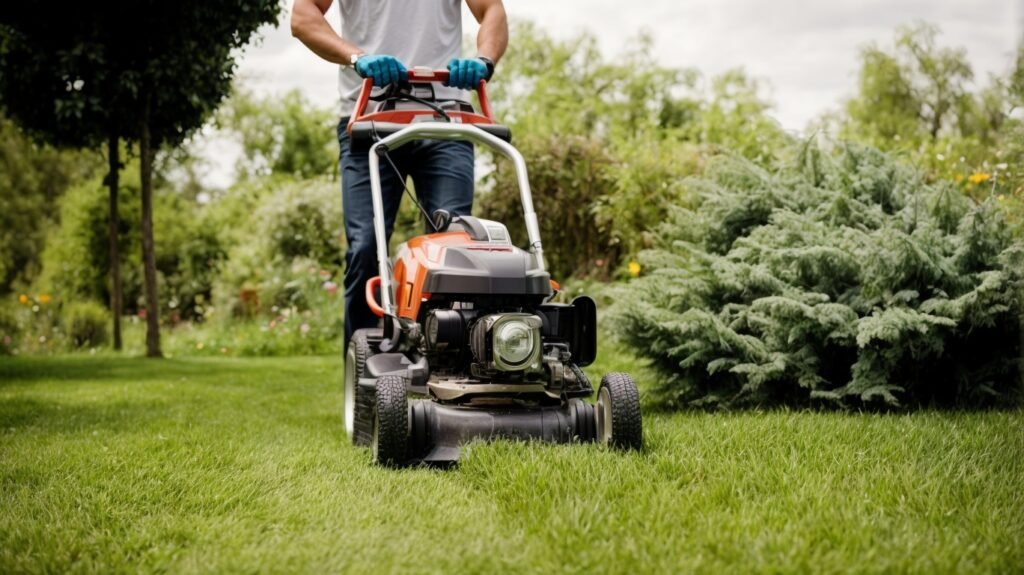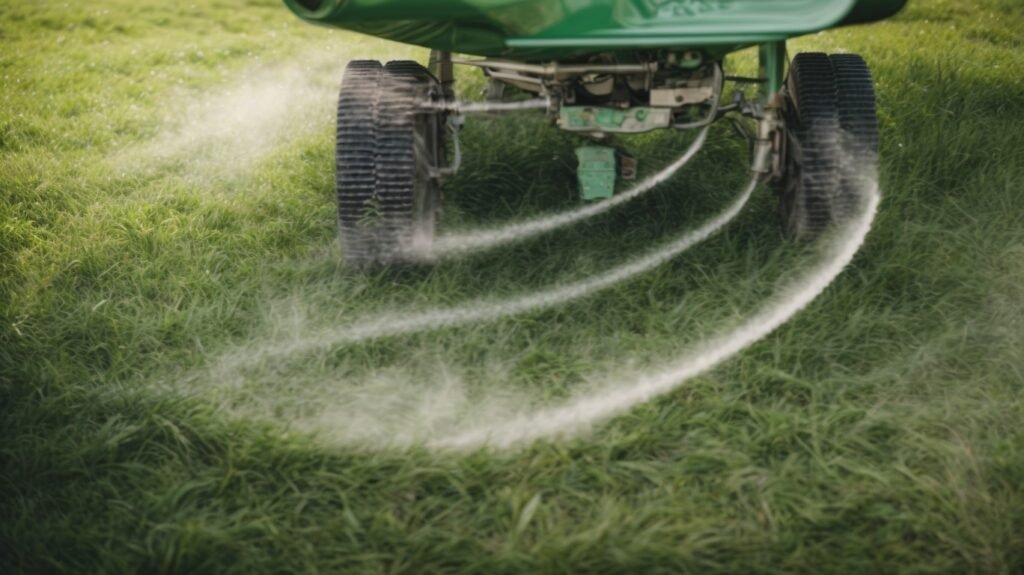Are you struggling to find the perfect grass cutting height for your lawn? Look no further! In this guide, we will explore the process of finding optimal grass cutting heights and offer tips for selecting the right lawn mower.
Key Takeaways:
- Grass cutting heights should be determined based on the specific type of grass you have in your lawn.
- Cutting grass too short can stress the plant and make it more susceptible to weeds, drought, and heat damage.
- Grass that is too long can create an ideal habitat for insects and critters.
- Cool-season grasses typically have a height range of 1-4 inches, while warm-season grasses vary depending on the specific type.
- The general rule of thumb is to never remove more than one third of the grass blade length at a single cutting.
The Impact of Grass Cutting Heights on Lawn Health
Understanding the impact of grass cutting heights is crucial for maintaining a lush and healthy lawn. Cutting grass too short can stress the plant, while letting it grow too long may create an ideal habitat for insects and critters. To strike the right balance, it’s important to follow proper grass cutting techniques that promote optimal growth and prevent potential issues.

Cutting grass too short can have detrimental effects on your lawn’s health. When you mow the grass too low, it puts stress on the plant, making it more susceptible to weeds, drought, and heat damage. Additionally, cutting too short inhibits the grass’s ability to photosynthesize, reducing its ability to produce energy and grow strong. To avoid these problems, avoid removing more than one-third of the grass blade length at a single cutting. This allows the grass to maintain a healthy root system and recover quickly.
On the other hand, letting the grass grow too long can also cause problems. Tall grass can create an ideal habitat for insects, critters, and disease-causing organisms. It can also lead to uneven growth and make your lawn look unkempt. Therefore, it’s important to regularly mow your lawn and keep it at the recommended height for your specific grass type. Different grasses have different optimal cutting heights, so it’s essential to research and understand the requirements of your particular grass type.
| Grass Type | Optimal Cutting Height |
|---|---|
| Cool-Season Grasses | 1-4 inches |
| Warm-Season Grasses | Varies depending on the specific type |
By maintaining your lawn at the ideal grass height, you can promote healthy turf and prevent issues like snow mold and thatch buildup. Remember to research seasonal exceptions and consult experts or local resources for specific grass height recommendations in your region. By following proper grass cutting techniques and keeping your lawn at the optimal height, you can enjoy a vibrant and beautiful lawn that enhances the overall aesthetic appeal of your outdoor space.
Types of Grass and Their Recommended Cutting Heights
Different types of grass have specific height requirements to thrive, so knowing your grass type is essential for finding the ideal cutting height. Here are some common grass types and their recommended cutting heights:
Cool-Season Grasses
| Grass Type | Recommended Cutting Height |
|---|---|
| Kentucky Bluegrass | 1.5-2.5 inches |
| Fescue (Fine and Tall) | 2.5-3.5 inches |
| Perennial Ryegrass | 1.5-2.5 inches |
Cool-season grasses thrive in regions with colder temperatures and are known for their ability to withstand frost and mild drought conditions. These grasses typically have a height range of 1-4 inches, but it’s important to check the specific recommendations for your grass type to ensure optimal growth.
Warm-Season Grasses
| Grass Type | Recommended Cutting Height |
|---|---|
| Bermuda Grass | 0.5-1.5 inches |
| Zoysia Grass | 1-2 inches |
| St. Augustine Grass | 2.5-4 inches |
Warm-season grasses are commonly found in regions with hot and humid climates. They have varying cutting heights depending on the specific grass type. Bermuda grass, for example, should be cut shorter at around 0.5-1.5 inches, while St. Augustine grass thrives at a height of 2.5-4 inches. It’s important to research and follow the recommended cutting height for your particular grass type to maintain a healthy lawn.

Remember, these are just general recommendations, and it’s always a good idea to consult local experts or resources for specific grass height recommendations in your region. By keeping your lawn at the ideal height, you not only promote healthy turf but also prevent issues like snow mold and thatch buildup. So, take the time to understand your grass type and adjust your cutting height accordingly for a beautiful and thriving lawn.
Cool-Season Grasses: Finding the Sweet Spot
Cool-season grasses, such as Kentucky bluegrass and tall fescue, have specific height ranges that promote healthy growth and resilience. Maintaining these grasses at the right height is crucial for ensuring a lush and vibrant lawn. Too short, and you risk damaging the grass and leaving it vulnerable to various issues. Too long, and you provide a comfortable haven for pests and critters.
For cool-season grasses, the recommended cutting heights typically fall within the range of 1 to 4 inches. This optimal range helps the grass maintain a strong root system, resist weeds, and withstand environmental stressors like drought and heat. By keeping your lawn within this height range, you encourage healthy turf growth and promote its ability to recover from damage caused by foot traffic or pests.

When it comes to cutting cool-season grasses, it’s important to follow the one-third rule. This rule advises never removing more than one-third of the grass blade length at a single cutting. By adhering to this rule, you prevent shock and stress to the grass, allowing it to recover quickly and maintain its strength and resilience.
| Grass Type | Recommended Height Range (in inches) |
|---|---|
| Kentucky Bluegrass | 1.5 – 2.5 |
| Tall Fescue | 2 – 4 |
| Ryegrass | 1.5 – 2.5 |
Remember to consider any seasonal exceptions or local recommendations for your specific region. Different climate conditions and grass varieties may require slight adjustments to the recommended cutting heights. Consulting with local experts or resources can provide valuable insights into the best practices for maintaining a healthy lawn in your area.
By understanding and implementing the proper cutting heights for cool-season grasses, you can achieve the perfect balance that promotes healthy growth, resilience, and a beautiful lawn. So grab your mower and give your cool-season grass the care it deserves!
Warm-Season Grasses: Understanding the Variations
Warm-season grasses, known for their resilience in hot climates, have different cutting height requirements depending on the specific grass type. It is important to understand and meet these requirements to ensure optimal growth and a vibrant lawn throughout the year.
One popular warm-season grass is Bermuda grass, which thrives in southern regions with its ability to withstand heat and drought. For Bermuda grass, the recommended cutting height range is typically between 1.5 to 2.5 inches. However, some varieties may have slightly different preferences, so it’s always a good idea to consult with local experts or resources for precise height recommendations.

Another warm-season grass worth mentioning is St. Augustine grass, a popular choice for its lush and dense growth. St. Augustine grass generally prefers a cutting height between 2.5 to 4 inches. This taller height helps shade the soil and promotes strong root development, making it more tolerant to heat and drought.
Remember, maintaining warm-season grasses at their optimal cutting heights is crucial for their overall health and appearance. By following these guidelines and staying within the recommended ranges, you can ensure that your warm-season grass thrives in even the hottest climates, creating a stunning lawn all year round.
| Warm-Season Grass Type | Recommended Cutting Height |
|---|---|
| Bermuda grass | 1.5 to 2.5 inches |
| St. Augustine grass | 2.5 to 4 inches |
The One-Third Rule: A Crucial Cutting Technique
Adhering to the one-third rule when mowing your lawn helps maintain the perfect balance between grass length and overall health. This fundamental grass cutting practice ensures that you never remove more than one third of the grass blade length at a single cutting.

By following this rule, you allow the grass to retain enough leaf surface to continue photosynthesis and promote healthy growth. Cutting more than one third of the grass blade can stress the plant, making it more susceptible to weeds, drought, and heat damage. On the other hand, leaving the grass too long can create an ideal habitat for insects and critters, leading to potential lawn issues.
To implement the one-third rule effectively, it is essential to determine the recommended cutting height for your specific grass type, as these heights can vary. Cool-season grasses, such as Kentucky bluegrass and perennial ryegrass, generally have a height range of 1-4 inches. Warm-season grasses like Bermuda grass and Zoysiagrass have different cutting height requirements depending on the specific type.
| Grass Type | Recommended Cutting Height (in inches) |
|---|---|
| Cool-Season Grasses | 1-4 |
| Bermuda Grass | 0.5-2 |
| Zoysiagrass | 1-2 |
It’s crucial to research seasonal exceptions and consult experts or local resources for specific grass height recommendations in your region. These resources can provide valuable insights, taking into account factors like climate, soil conditions, and grass varieties prevalent in your area.
By diligently applying the one-third rule and maintaining the optimal grass cutting height, you can promote a healthy and vibrant turf, reducing the risk of issues like snow mold and thatch buildup. Remember, a well-maintained lawn not only enhances the aesthetics of your outdoor space but also serves as a tranquil retreat for you and your family to enjoy.
Researching Seasonal Exceptions and Local Recommendations
While general guidelines exist for grass cutting heights, it’s important to consider seasonal exceptions and local recommendations for the best results. Different regions and climates may require specific grass heights to promote optimal growth and health. By researching seasonal exceptions and consulting experts or local resources, you can ensure that you’re making informed decisions for your lawn.
One way to gather information is to reach out to your local cooperative extension office or garden center. They have knowledgeable staff who can provide insights into the best grass cutting heights for your area. They can also guide you on how to adjust your cutting routine based on the time of year and the specific type of grass in your lawn.
Additionally, online resources and forums dedicated to lawn care can offer valuable information and advice. Connect with other homeowners or professionals in your region to discuss grass cutting techniques and learn from their experiences. These platforms often provide insights into seasonal exceptions and local recommendations that may not be widely known.
Table: Recommended Grass Cutting Heights for Different Seasons
| Grass Type | Spring | Summer | Fall | Winter |
|---|---|---|---|---|
| Cool-Season Grasses | 2-3 inches | 3-4 inches | 2-3 inches | 2-3 inches |
| Warm-Season Grasses | 1.5-2.5 inches | 2-3.5 inches | 1.5-2.5 inches | 1.5-2.5 inches |
- Spring: As the grass begins to grow, gradually reduce the height of your lawn mower blades to encourage healthy growth.
- Summer: Raise the cutting height slightly to protect the grass from heat stress and conserve moisture.
- Fall: Lower the cutting height gradually to help the grass prepare for winter and prevent snow mold.
- Winter: Keep the grass at a moderate height to provide insulation against cold weather and minimize damage.
By considering seasonal exceptions and local recommendations, you can achieve the perfect grass cutting height for your lawn. Remember to adjust your cutting routine accordingly, keeping in mind the specific grass type and the unique needs of your region. With proper research and care, you’ll be able to maintain a healthy and vibrant lawn all year round.
Choosing the Right Lawn Mower for Optimal Cutting
The right lawn mower can make all the difference in achieving the optimal grass cutting height, so let’s explore the key factors to consider when choosing one. With a wide variety of options available, it’s important to select a mower that suits your specific needs and lawn conditions.
First and foremost, you’ll want to determine whether a push mower or a self-propelled mower is best for you. Push mowers are ideal for smaller yards, providing a more cost-effective and environmentally friendly option. Self-propelled mowers, on the other hand, are perfect for larger yards or if you prefer less physical exertion during mowing. They offer greater convenience and ease of use.
Next, consider the cutting width and height adjustment capabilities of the mower. A wider cutting width means you can cover more ground in less time, while a mower with adjustable height settings allows you to achieve the ideal grass length for your specific grass type. Look for mowers with multiple height options for maximum flexibility.
It’s also essential to think about the power source. Gas-powered mowers are the most common and offer reliable performance, but they can be noisier and require more maintenance. Electric mowers, on the other hand, are quieter, more eco-friendly, and require less maintenance. However, they may have limitations on cutting width and run time, depending on whether they are corded or cordless.
| Mower Type | Pros | Cons |
|---|---|---|
| Gas-powered | Powerful performance | Noisier, more maintenance |
| Electric (corded) | Quiet, eco-friendly | Limited cutting width, cord restrictions |
| Electric (cordless) | Quiet, eco-friendly, portable | Limited run time, may require battery charging |
Lastly, consider additional features and accessories that may enhance your mowing experience. Some mowers come equipped with mulching capabilities, allowing you to recycle the grass clippings back into the lawn for added nutrients. Others have bagging attachments for a neater appearance. Look for mowers with ergonomic handles, easy-to-reach controls, and sturdy wheels for optimal maneuverability.

By carefully considering these factors when selecting a lawn mower, you can ensure that you achieve the optimal grass cutting height for a healthy and beautiful lawn.
Additional Lawn Care Tips for Healthy Turf
Besides proper grass cutting techniques, implementing these additional lawn care tips can contribute to a lush and thriving lawn.
- Regular watering: Ensure your lawn receives adequate water, especially during dry spells. Deep watering once or twice a week is preferable over frequent shallow watering, as it encourages deep root growth and enhances drought resistance.
- Aeration: Compacted soil can hinder grass growth and nutrient absorption. Consider aerating your lawn annually to improve airflow, water penetration, and root development. You can rent an aerator or hire a professional for this task.
- Fertilization: Providing your lawn with the right nutrients is crucial for its overall health. Use a slow-release fertilizer according to your grass type and follow manufacturer’s guidelines for application. Avoid over-fertilization, as it can lead to excessive growth and weaken the grass.
- Weed control: Regularly inspect your lawn for weeds and address them promptly. Use appropriate herbicides or pull out weeds manually. Mulching and maintaining proper grass height can also help prevent weed growth by shading the soil.

“A well-maintained lawn requires more than just cutting grass at the right height. Consistent lawn care practices, such as proper watering, aerating, fertilizing, and weed control, are essential for creating a healthy turf.”
Finally, don’t forget to maintain your lawn equipment to ensure optimal performance. Regularly sharpen blades, change oil, and clean your lawn mower to promote clean and precise cuts. Taking care of your equipment not only extends its lifespan but also contributes to a better looking lawn.
| Lawn Care Tips | Grass Cutting Techniques | Lawn Maintenance Tips |
|---|---|---|
| Regular watering | Proper grass cutting height | Sharpening mower blades |
| Aeration | One-third rule | Changing mower oil |
| Fertilization | Researching seasonal exceptions | Cleaning mower after use |
| Weed control | Consulting local resources |
By incorporating these lawn care tips into your routine, you can create an environment that promotes healthy turf growth, minimizes common problems, and showcases a beautiful lawn that you can be proud of.
Avoiding Common Pitfalls and Preventing Issues
Preventing common issues like snow mold and thatch buildup starts with proper grass cutting techniques and regular lawn maintenance. By following a few simple tips, you can keep your lawn healthy and vibrant all year round.
1. Don’t cut your grass too short
One common mistake homeowners make is cutting their grass too short. This can cause stress to the grass and make it more susceptible to weeds, drought, and heat damage. Instead, aim to keep your grass at the recommended height for your specific type of grass. Cool-season grasses typically have a recommended cutting height range of 1-4 inches, while warm-season grasses vary depending on the specific type. By maintaining the proper grass height, you’ll promote healthy growth and prevent issues down the line.

2. Avoid overgrown grass
On the other hand, leaving your grass too long can create an ideal habitat for insects and critters. Regular mowing is essential to keep your lawn looking neat and prevent unwanted pests from taking over. Remember the one-third rule: never remove more than one third of the grass blade length at a single cutting. This will ensure that your lawn stays healthy and lush.

3. Research seasonal exceptions and consult local resources
Every region has its own unique climate and growing conditions, so it’s important to research seasonal exceptions and consult local resources for specific grass height recommendations. Local experts, gardening forums, and university extension services can provide valuable information on the best grass cutting practices for your area. By following these recommendations, you’ll be able to tailor your lawn care routine to suit the specific needs of your region.
Remember, proper grass cutting techniques and regular lawn maintenance are key to preventing common issues like snow mold and thatch buildup. By keeping your grass at the ideal height, you’ll promote healthy turf and ensure a beautiful lawn that you can enjoy year-round.
Conclusion: Achieving the Perfect Grass Cutting Height
By understanding the impact of grass cutting heights and following the proper techniques, you can achieve the optimal length for your lawn and enjoy a lush, resilient, and vibrant outdoor space.
When it comes to grass cutting heights, it’s crucial to consider the specific type of grass you have in your lawn. Cutting the grass too short can stress the plant and leave it more vulnerable to weeds, drought, and damage from heat. On the other hand, grass that is too long creates an ideal habitat for insects and critters. To strike the right balance, aim for a height range of 1-4 inches for cool-season grasses, while warm-season grasses may have varying optimal heights depending on the specific type.
The golden rule of grass cutting is to never remove more than one third of the grass blade length in a single cutting. This practice, known as the one-third rule, ensures that the grass remains healthy and does not experience shock or stress from being cut too short. Remember to research seasonal exceptions and consult experts or local resources for specific grass height recommendations in your region.
In addition to maintaining the optimal grass cutting height, there are other practices you can follow to promote a healthy lawn. Regularly mowing your lawn, watering it properly, and fertilizing as needed will all contribute to the overall health and vibrancy of your turf. By taking these steps, you can prevent common issues like snow mold and thatch buildup, and ensure that your lawn remains in top condition throughout the year.
Selecting the right lawn mower for your needs is also crucial in achieving the perfect grass cutting height. Consider factors such as the size of your lawn, your preferred cutting method (mulching, bagging, or side discharge), and the desired cutting height options available on the mower. Choosing the appropriate mower will help you achieve precision and efficiency in maintaining your lawn.
In conclusion, finding the optimal grass cutting height is essential for the health and appearance of your lawn. By understanding the impact of grass cutting heights, following the one-third rule, researching recommendations for your specific grass type and region, and selecting the right lawn mower, you can achieve a beautiful and thriving outdoor space that you can enjoy all year round.
FAQ
What happens if I cut my grass too short?
Cutting grass too short can stress the plant and make it more susceptible to weeds, drought, and heat damage.
How long should I let my grass grow?
Grass cutting heights should be determined based on the specific type of grass you have in your lawn. For cool-season grasses, the recommended height range is 1-4 inches, while warm-season grasses vary depending on the specific type.
Can cutting my grass too long cause problems?
Yes, grass that is too long can create an ideal habitat for insects and critters, and may also lead to issues like thatch buildup.
How much grass should I remove at each cutting?
The general rule of thumb is to never remove more than one third of the grass blade length at a single cutting. This ensures healthy growth and prevents stress on the grass.
Are there any exceptions to the recommended grass cutting heights?
It’s important to research seasonal exceptions and consult experts or local resources for specific grass height recommendations in your region, as different climates and conditions may require adjustments to the general guidelines.
How do I choose the right lawn mower for optimal cutting?
When selecting a lawn mower, consider factors such as the size of your lawn, the type of grass you have, and your personal preferences. Look for features like adjustable cutting heights and mulching options for a versatile and efficient cutting experience.
Are there any additional lawn care tips I should know?
In addition to maintaining the right grass cutting height, aerating the soil, regularly watering and fertilizing, and promptly addressing any signs of disease or pest infestations can contribute to a healthy and vibrant lawn.
How can I prevent common issues like snow mold and thatch buildup?
To prevent snow mold, ensure that your grass is cut to the recommended length before winter, and remove excess debris from the lawn. To avoid thatch buildup, practice regular dethatching and ensure proper lawn maintenance techniques.




